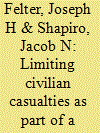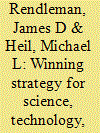|
|
|
Sort Order |
|
|
|
Items / Page
|
|
|
|
|
|
|
| Srl | Item |
| 1 |
ID:
090833


|
|
|
|
|
| Publication |
2009.
|
| Summary/Abstract |
Candidates often make ambiguous statements about the policies they intend to pursue. In theory, ambiguity affects how voters make choices and who wins elections. In practice, measurement and endogeneity problems have impeded empirical research about the consequences of ambiguity. We conducted survey experiments that overcame these obstacles by manipulating a common form of ambiguity: the imprecision of candidate positions. Our data show that, on average, ambiguity does not repel and may, in fact, attract voters. In nonpartisan settings, voters who have neutral or positive attitudes toward risk, or who feel uncertain about their own policy preferences, tend to embrace ambiguity. In partisan settings, voters respond even more positively to ambiguity; they optimistically perceive the locations of ambiguous candidates from their own party without pessimistically perceiving the locations of vague candidates from the opposition. We further find, through analysis of two additional new data sets, that candidates often take-and voters frequently perceive-ambiguous positions like the ones in our experiments. The pervasive use of ambiguity in campaigns fits with our experimental finding that ambiguity can be a winning strategy, especially in partisan elections.
|
|
|
|
|
|
|
|
|
|
|
|
|
|
|
|
| 2 |
ID:
151759


|
|
|
|
|
| Summary/Abstract |
Military commanders in wartime have moral obligations to abide by international norms and humanitarian laws governing their treatment of noncombatants. How much risk to their own forces they must take to limit harm to civilians in the course of military operations, however, is unclear. The principle of proportionality in the law of armed conflict all but necessitates that they make a utilitarian calculation: potential harm to civilians must always be balanced against military value when considering actions that could hurt innocents. In asymmetric conflicts, such as most counterinsurgencies, information flows, collaboration, and ultimately the support of the local population can be key to achieving strategic objectives. Thus, limiting casualties to noncombatants and other actions that alienate the population in these types of conflicts is a key part of a winning strategy. The concept of “courageous restraint” was created to express this principle to NATO and U.S. forces fighting in Afghanistan.
|
|
|
|
|
|
|
|
|
|
|
|
|
|
|
|
| 3 |
ID:
108954


|
|
|
|
|
| Publication |
2011.
|
| Summary/Abstract |
The research, innovation, and engineering triumphs of the United States over the past century are a child of a technologically and scientifically superior workforce. That expertise is at risk, however. Recent challenges to acquiring new space systems are attributable, in significant measure, to the loss of science, technology, engineering, and math (STEM) skills and experience. Evolving space mission needs demand improved STEM skills and experience across the spectrum of the space workforce. Unfortunately, many remedial programs have failed, and economic reality confronts the government, industry, and academic establishments as they are challenged to develop education and professional development programs responsive to STEM needs. To continue its leadership in global space activities, the United States needs to employ a comprehensive strategy to ensure it has a workforce with the skills to achieve short-term and long-term success. It can do this by increasing the numbers, and improving the quality of education and academic development of STEM-educated students, graduates, teachers, professors, and their mentors.
|
|
|
|
|
|
|
|
|
|
|
|
|
|
|
|
|
|
|
|
|